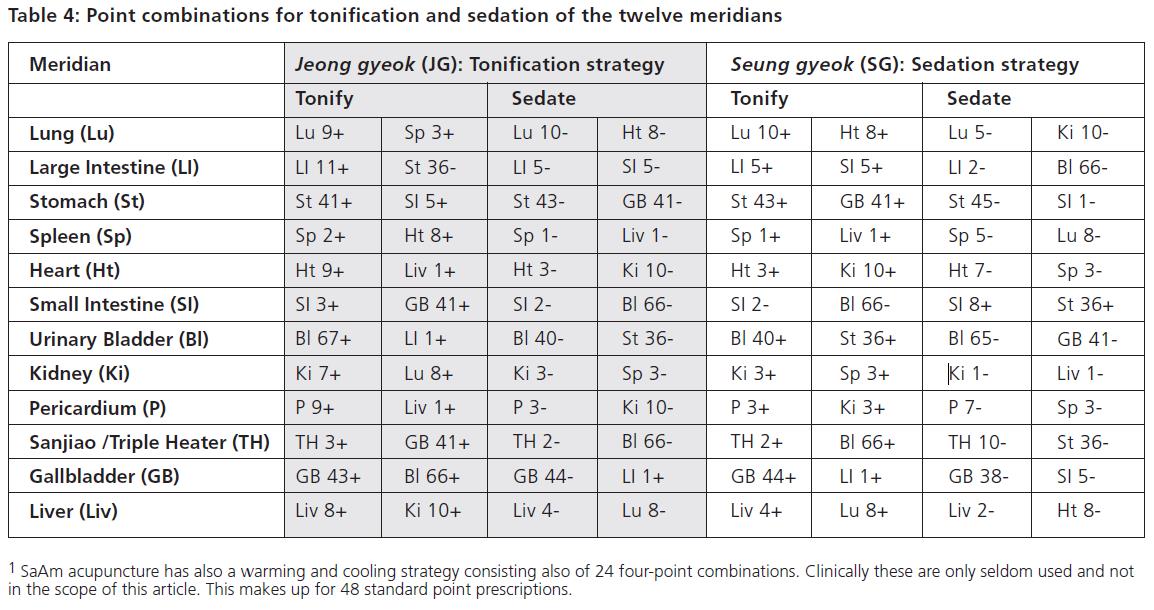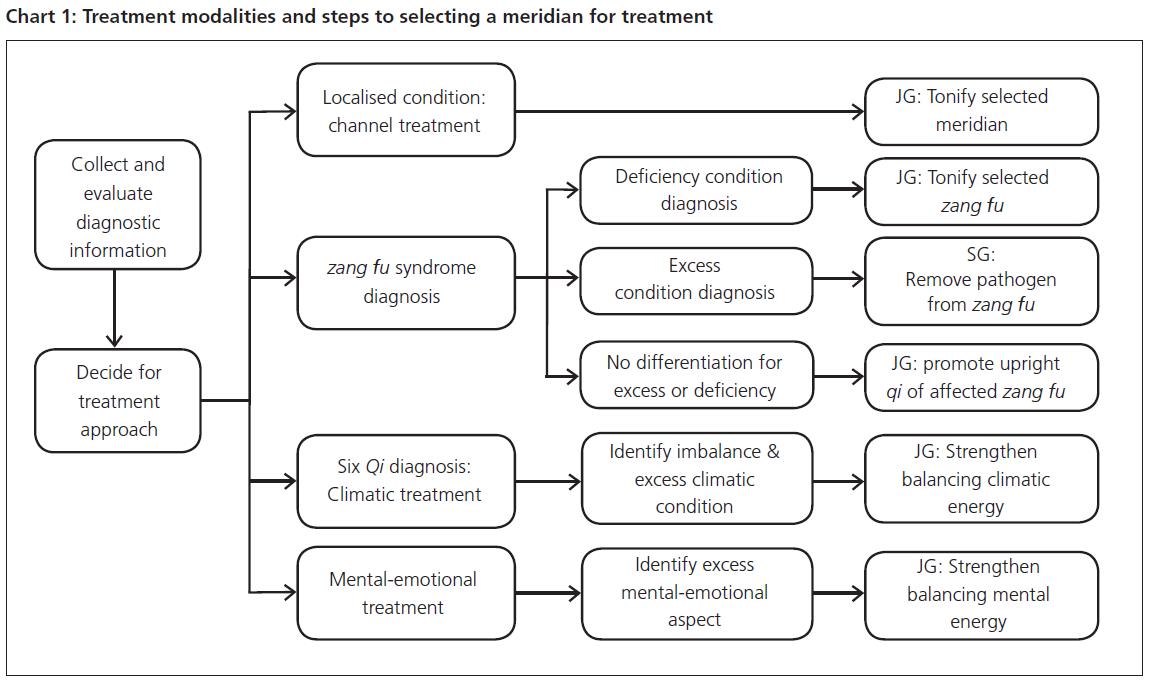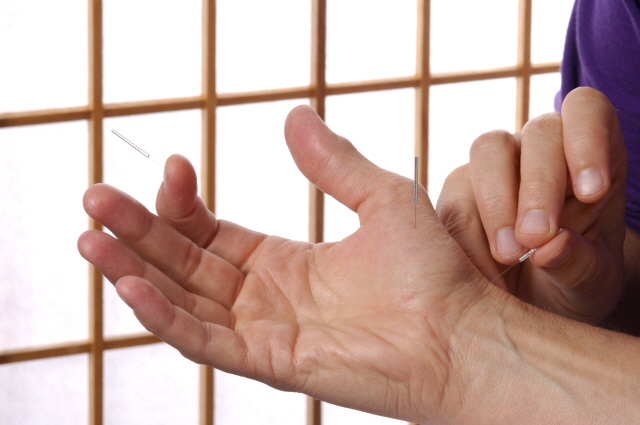By Andreas Brüch, The European Journal of Oriental Medicine
Each of the 12 meridians can be addressed with a tonification and sedation strategy, resulting in 24 basic acupuncture point prescriptions.1 Each of these prescriptions uses four predefined acupoints from the shu-transport-points (Five Element Antique points 五兪穴, Korean: 오수혈). The selection of points as well as their tonification or sedation is decided upon based on the promoting and controlling cycle of Five Element theory. The first two needles follow the principle of using the promoting cycle as described in Huang Di Neijing Suwen, chapter 69: ‘In cases of deficiency tonify the mother; and in cases of excess sedate the son’. Master SaAm’s genius was to expand the point prescriptions by adding two more points utilising also the controlling cycle and in that way exerting increased influence on the manipulated meridian’s energy. The tonification strategy is named by the Korean term jeong gyeok. Sedation is named seung gyeok.
-
Tonification method: jeong gyeok (정격)
- Promoting cycle: 1st point: tonify the mother point of the own meridian; 2nd point: tonify the element point of the mother meridian
- Controlling cycle: 3rd point: sedate the grandmother point of the own meridian; 4th point: sedate the element point of the grandmother point
-
Sedation method: seung gyeok (승격)
- Promoting cycle: 1st point: sedate the son point of the own meridian; 2nd point: sedate the element point of the son meridian
- Controlling cycle: 3rd point: tonify the grandmother point of the own meridian; 4th point: tonify the element point of the grandmother meridian

Table 4 shows the point combinations for tonification and sedation for all 12 meridians according to the principles described above. In clinical practice the tonification strategy (jeong gyeok/JG) is used for most cases (about 85 per cent).
For tonification and sedation of acupuncture points Korean acupuncturists largely use the same methods also established in classical Chinese medicine, namely inserting the needle in or against the meridian flow, inserting while inhaling or exhaling, removing the needle while exhaling or inhaling, and closing or leaving the point open when removing needles.
Additionally, many SaAm practitioners apply a complex yet effective principle of clockwise or counter-clockwise needle rotation, taking into account the yin and yang factors of the particular meridian, side of the body, upper or lower limbs, time of day and the patient’s gender (Ahn et al., 2010). This method was described by Lee Chan (李梴) in the classic Yi Xu Ru Men (醫學入門/Introduction to Medicine) in 1575, but is beyond the scope of this article (Lee, 2018). Clinically every SaAm four-point prescription is applied only unilaterally on the right or left extremities. Following traditional rules, the four points are used on the right for women and on the left for men except for one-sided conditions where the SaAm pattern is administered contralateral to the diseased side.
Combining the SaAm four needle strategy with supplemental treatment
The central SaAm treatment strategy can be supplemented usually on the opposite side of the body by needling additional acupuncture points or using moxibustion, gua sha and other treatment methods.
The task of this procedure is to have an extended treatment for disease aspects not covered by the selected main SaAm approach such as addressing the disease from other Oriental medicine perspective, treating secondary conditions or symptomatic and reactive points. SaAm acupuncture is an open system and it is no problem to select points from a broad theoretical or methodological background. This could be for example zang fu theory, Eight Extraordinary Vessels, Master Tong acupuncture, ear acupuncture, Korean hand acupuncture and so forth (Choo, Brüch, Janowitz, 2017). In more advanced SaAm acupuncture there is also the possibility to use several four-point combinations in one treatment or to apply only selected points from a four-needle strategy.
Modalities of treatment in SaAm acupuncture
As already explained, the four-point combinations not only function to treat climatic imbalances and mental emotional conditions but to also address all major conventional disease categories of standard Chinese acupuncture. This makes SaAm acupuncture a comparatively fast and easy to use acupuncture style. In summary, the treatment with the SaAm tonification and sedation strategies can be classified in the following four main categories (Choo, Brüch, Janowitz, 2017):
- Local channel treatment: In case a condition is allocated to the pathway or area covered by a particular meridian, for example, pain from trauma or bi syndrome, the meridian’s Upright Qi (zhen qi) usually is strengthened with the tonification strategy jeong gyeok.
- Treatment according to zang fu syndrome diagnosis: Conditions explained by zang fu theory can be directly treated with the point combination related to the affected organ. In SaAm acupuncture all zang fu diagnoses are classified according to deficiency or excess conditions. In case of deficiency the upright qi is considered weak and in excess there is an overabundance of pathogenic qi (Cha et al., 2014). This means all syndrome patterns of a particular zang fu usually classified as deficiency can be addressed by the jeong gyeok combination (JG). Diagnoses in the excess category can be treated with seung gyeok (SG). For example, Liver JG addresses Liver blood deficiency, Liver yin deficiency or Liver Wind due to Blood deficiency. Liver sedation (SG) is used for Liver yang rising, Liver Wind, Liver Heat, Liver Fire, etc. A more general approach is to address a zang fu’s imbalance by not even making a differentiation between excess and deficiency, but instead following in every case the idea of always boosting the upright qi of the diseased organ with the point combination of jeong gyeok in order to correct the problem. For instance, simple Liver qi stagnation can be addressed following this principle (Choo, Brüch, Janowitz, 2017). The detailed theoretical rationale for these approaches goes beyond this article. However, this makes SaAm acupuncture an easy to use method in case of zang fu syndromes because the practitioner does not need to memorise and apply so many point combinations as in conventional Chinese medicine, instead it follows a universal principle for point selection.
- Six Qi climatic treatment: This modality follows the above described model of climatic conditions. The diagnosed climatic disharmony is usually balanced by tonification of the opposing climatic factor. For example, signs and symptoms that indicate a general tendency to let too much energy or bodily fluids go to the outside, combined with Heat signs like acne, sweating, inflamed skin conditions or hot flushes can be balanced by promoting the Liver’s astringent, inwardly directed, moving and cooling Wind characteristic according to Six Qi theory. This can be due to pathogenic influences or long-time constitutional factors.
- Mental-emotional treatment: This category covers problems that can be understood and treated by Dr Hong-Gyeong Kim’s model of mental-emotional conditions that has been described above. For example, Foot jue yin Liver meridian’s tonification promotes self-esteem and assertiveness. This balances Hand shao yang Triple Heater’s characteristic feelings of inferiority, sarcasm or low self-confidence.
An overview of these four treatment categories is shown in chart 1. In clinical practice it often happens that several of these modalities may overlap. Thus, considering multiple analytical perspectives is helpful to understand the patient’s disease and select the best meridian for treatment.


































